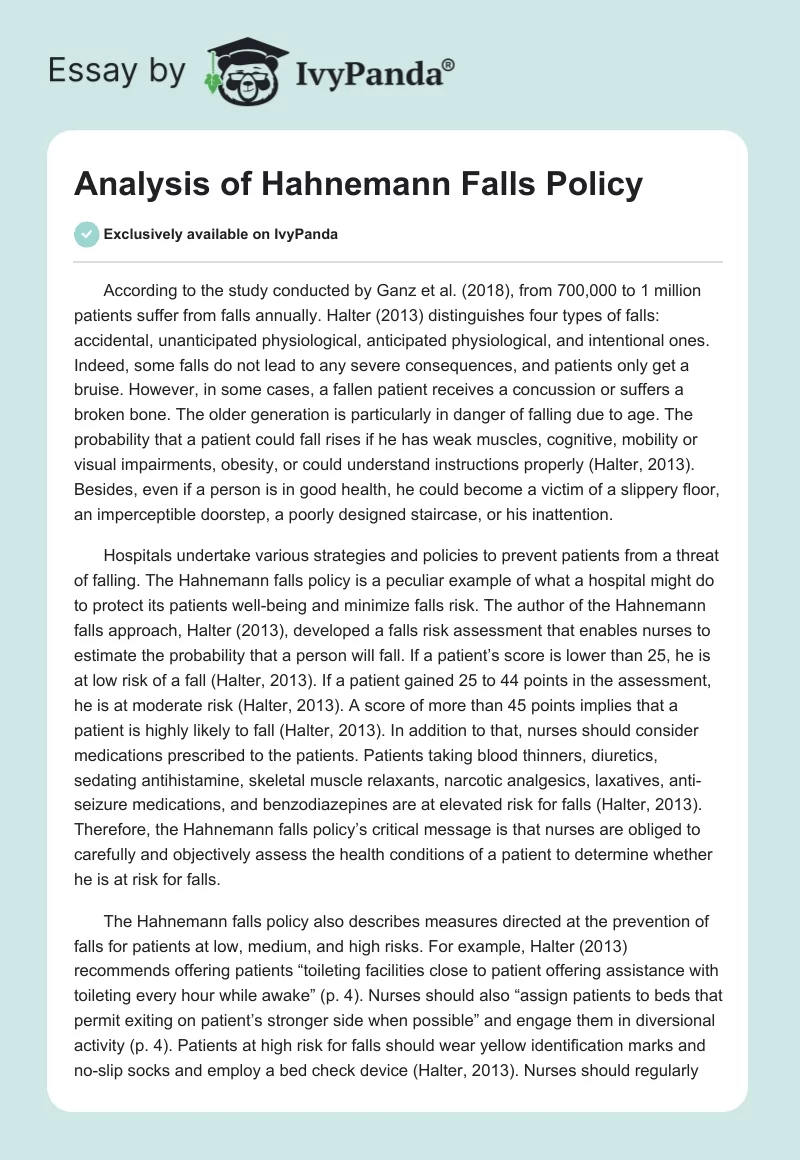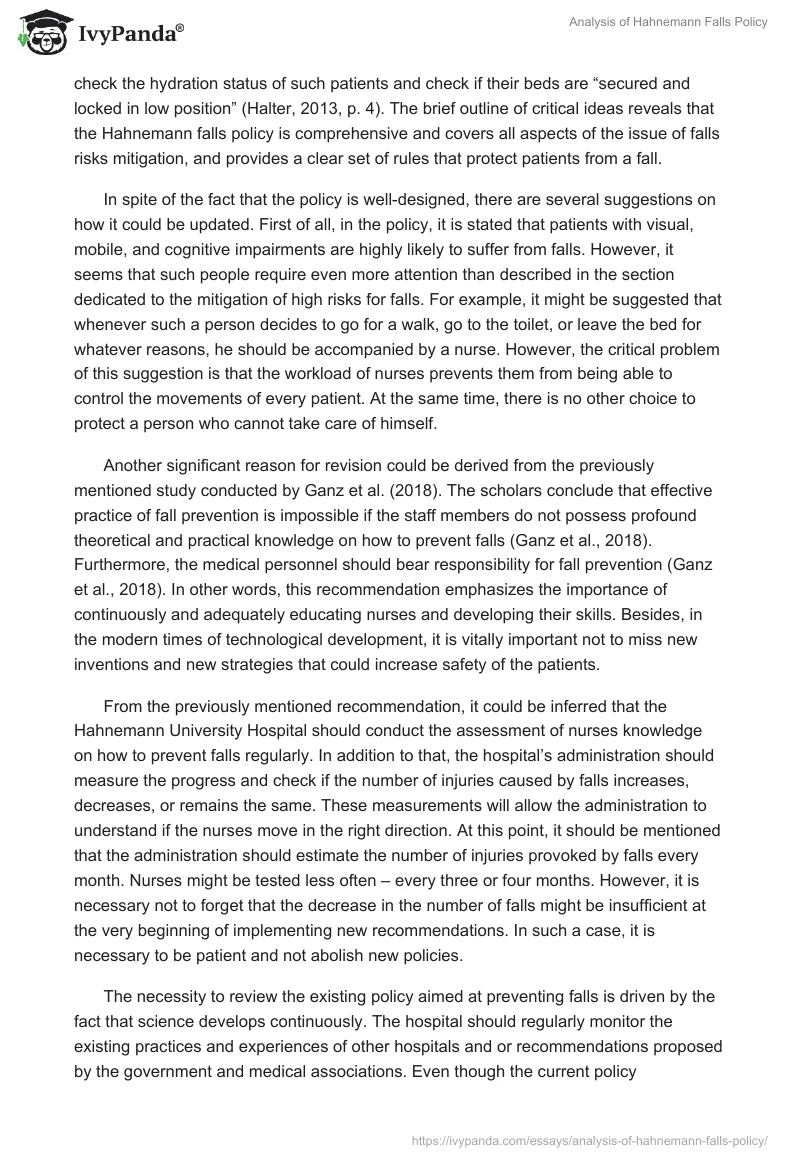According to the study conducted by Ganz et al. (2018), from 700,000 to 1 million patients suffer from falls annually. Halter (2013) distinguishes four types of falls: accidental, unanticipated physiological, anticipated physiological, and intentional ones. Indeed, some falls do not lead to any severe consequences, and patients only get a bruise. However, in some cases, a fallen patient receives a concussion or suffers a broken bone. The older generation is particularly in danger of falling due to age. The probability that a patient could fall rises if he has weak muscles, cognitive, mobility or visual impairments, obesity, or could understand instructions properly (Halter, 2013). Besides, even if a person is in good health, he could become a victim of a slippery floor, an imperceptible doorstep, a poorly designed staircase, or his inattention.
Hospitals undertake various strategies and policies to prevent patients from a threat of falling. The Hahnemann falls policy is a peculiar example of what a hospital might do to protect its patients well-being and minimize falls risk. The author of the Hahnemann falls approach, Halter (2013), developed a falls risk assessment that enables nurses to estimate the probability that a person will fall. If a patient’s score is lower than 25, he is at low risk of a fall (Halter, 2013). If a patient gained 25 to 44 points in the assessment, he is at moderate risk (Halter, 2013). A score of more than 45 points implies that a patient is highly likely to fall (Halter, 2013). In addition to that, nurses should consider medications prescribed to the patients. Patients taking blood thinners, diuretics, sedating antihistamine, skeletal muscle relaxants, narcotic analgesics, laxatives, anti-seizure medications, and benzodiazepines are at elevated risk for falls (Halter, 2013). Therefore, the Hahnemann falls policy’s critical message is that nurses are obliged to carefully and objectively assess the health conditions of a patient to determine whether he is at risk for falls.
The Hahnemann falls policy also describes measures directed at the prevention of falls for patients at low, medium, and high risks. For example, Halter (2013) recommends offering patients “toileting facilities close to patient offering assistance with toileting every hour while awake” (p. 4). Nurses should also “assign patients to beds that permit exiting on patient’s stronger side when possible” and engage them in diversional activity (p. 4). Patients at high risk for falls should wear yellow identification marks and no-slip socks and employ a bed check device (Halter, 2013). Nurses should regularly check the hydration status of such patients and check if their beds are “secured and locked in low position” (Halter, 2013, p. 4). The brief outline of critical ideas reveals that the Hahnemann falls policy is comprehensive and covers all aspects of the issue of falls risks mitigation, and provides a clear set of rules that protect patients from a fall.
In spite of the fact that the policy is well-designed, there are several suggestions on how it could be updated. First of all, in the policy, it is stated that patients with visual, mobile, and cognitive impairments are highly likely to suffer from falls. However, it seems that such people require even more attention than described in the section dedicated to the mitigation of high risks for falls. For example, it might be suggested that whenever such a person decides to go for a walk, go to the toilet, or leave the bed for whatever reasons, he should be accompanied by a nurse. However, the critical problem of this suggestion is that the workload of nurses prevents them from being able to control the movements of every patient. At the same time, there is no other choice to protect a person who cannot take care of himself.
Another significant reason for revision could be derived from the previously mentioned study conducted by Ganz et al. (2018). The scholars conclude that effective practice of fall prevention is impossible if the staff members do not possess profound theoretical and practical knowledge on how to prevent falls (Ganz et al., 2018). Furthermore, the medical personnel should bear responsibility for fall prevention (Ganz et al., 2018). In other words, this recommendation emphasizes the importance of continuously and adequately educating nurses and developing their skills. Besides, in the modern times of technological development, it is vitally important not to miss new inventions and new strategies that could increase safety of the patients.
From the previously mentioned recommendation, it could be inferred that the Hahnemann University Hospital should conduct the assessment of nurses knowledge on how to prevent falls regularly. In addition to that, the hospital’s administration should measure the progress and check if the number of injuries caused by falls increases, decreases, or remains the same. These measurements will allow the administration to understand if the nurses move in the right direction. At this point, it should be mentioned that the administration should estimate the number of injuries provoked by falls every month. Nurses might be tested less often – every three or four months. However, it is necessary not to forget that the decrease in the number of falls might be insufficient at the very beginning of implementing new recommendations. In such a case, it is necessary to be patient and not abolish new policies.
The necessity to review the existing policy aimed at preventing falls is driven by the fact that science develops continuously. The hospital should regularly monitor the existing practices and experiences of other hospitals and or recommendations proposed by the government and medical associations. Even though the current policy undertaken by the Hahnemann university hospital is sound, it does not mean that there is no space for improvement. The fact that the number of injuries caused by falls is still significant signalizes that a hospital should pay more attention to the issue.
To sum up, the current paper examined the Hahnemann falls policy. The conducted analysis reveals that the measures suggested by the Hahnemann hospital are comprehensive and well-thought. The policy describes a detailed strategy on how to assess the risk of every patient suffering from falls. The policy also contains recommendations on what nurses should do to help patients at the high, medium, and low risks for falls and how to behave if an accident had happened. Despite these strong sides, one could notice that the hospital does not give significant attention to the nurses education and regular measuring of the number of falls. The policy suggested by the Hahnemann university hospital will become even more effective if it makes nurses responsible for the incidents and motivates them to gain new knowledge in this field.
References
Ganz, A., Huang, C., Saliba, D., Shier, V., Berlowitz, D., Lukas, C.V., Pelczarski, K., Schoelles, K., Wallace, L.C., Neumann., P. (2018). Preventing falls in hospitals.Agency for Healthcare Research and Quality. Web.
Halter, M.P. (2013). Falls Prevention and Resource.Hahnemann University Hospital. Web.


